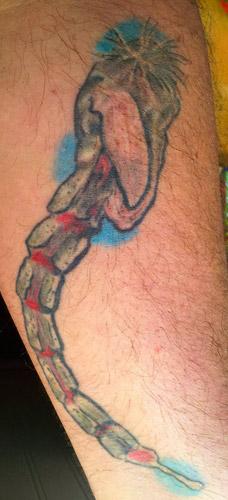“So what is that tattoo on your arm anyway?”
Advertisement
A lot of my conversations start that way with people who haven’t seen it before and where it goes from there really depends on who I am talking to. If it’s someone who doesn’t know me well but understands fly-fishing, I will tell them it is a chironomid and they will say, “Oh, that’s cool” and that’s the end of it. If the person is a good friend who also knows fishing, he will usually say something like, “Hahahaha! Are you out of your freaking mind?” But for those unlucky few who neither know me enough to tell me to shut up or what exactly a chironomid might be, they get to sit through my whole soliloquy on what they are, why they are important and why I love to fish them so much.
I’ll start out by giving them a little background about how chironomids, as we fish them, are generally the pupae stage of an insect that looks very much like a mosquito without the nasty blood sucking anti-social habits of its less universally appreciated look-alike. They range in size from an un-fishable dot in the water to the big bombers of the interior lakes that can be an inch or more in length. Chironomids make up 2/3 of a BC trout’s diet and are sometimes fed upon to the exclusion of all else. No matter what time of year it is, no matter whether it has been weeks since anybody saw a chironomid hatch, fishing one is always a good bet because even if they are not keyed upon, a hungry trout can be counted on to vacuum one up if he happens to notice it as he swims by.
Advertisement
Chironomids are also the friend of the clumsy fly tier or ham-handed fisherman. As long as you know the basic profile of a chironomid, paying particular attention to the slim tapered body, some ribbing and a bead head, it’s pretty tough to tie one that won’t catch fish. Because the presentation is very slow, even motionless, you don’t have to be Brian Chan to successfully fool large wary trout…upon occasion that is.
To the uninitiated, chironomid fishing can seem very basic, even boring. Usually people, especially beginners will use some sort of a float, (we call them indicators, not bobbers,) and just suspend the fly a foot or so off the bottom. That will work a lot of the time; sometimes it will work very well but, to get the most out of this kind of fishing, you really have to learn how fish see them and where they should be. You also need to determine which size and color of insect the trout are looking for. This can be done by throat pumping a fish or more commonly (and easily) by watching the water’s surface to see what is hatching. You will soon develop an instinct as to when a fish is checking out your fly; a couple of quick twitches will often spur a ferocious attack.
Advertisement
Usually this is the point in my little mini-lecture where the unfortunate recipient of my enthusiastic attention starts checking their watch and looking for the door. Really all they wanted to know is what exactly my odd looking tattoo is. I know it’s pretty much the same as asking a stranger how their day is going and having them actually tell you, but I can’t help it. There is much more to this seemingly sedentary pursuit than meets the casual eye and I love to see people start catching larger fish with more consistency once they actually get the bug for the bug, so to speak.
The other approach I’m fond of is to tell them it’s a tattoo of an alien fetus, strangely enough all I ever get in response to that is a knowing nod and a quick shuffle towards the nearest exit. I guess I understand that, I mean who gets a 12-inch insect permanently etched into their skin anyway, certainly not somebody with an ounce of common sense but then again, people who spend all day in a boat staring at a tiny orange bobber (ya, I said it) aren’t exactly known for having all their marbles still in the bag and I am certainly no exception, at least when it comes to fishing these tiny, important members of the trout food-chain.
